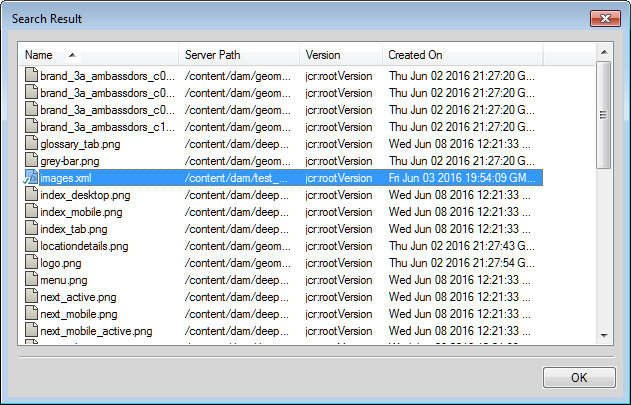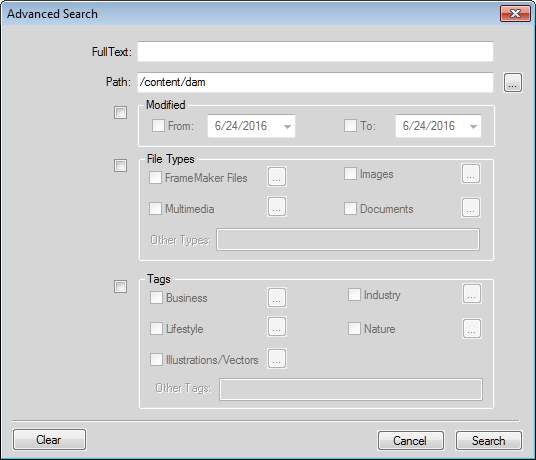Searching in the AEM repository
The AEM search functionality allows you to search for files in the selected AEM folder. The functionality includes:
Repository search
To search for a file in the repository:
1)Select a folder in which to search.
2)Enter the search string in the Enter Search String text box in the Repository Manager.

3)Click the Search Repository icon.
Based on the way your AEM server is setup, the search results are displayed in either of the two formats:
•Search Results dialog
The Search Result dialog appears if your AEM server does not have the XML Add-on installed.
The Search Result dialog displays the filename, server path, version, and date created for each file returned in the search results.

•Repository Search pod
The Repository Search pod appears if your AEM server has the XML Add-on installed.
The Repository Search pod displays the filename, context where the search term is found, element hierarchy, author, review status, and places where the corresponding file is used.

4)In the search results, right-click on a file to perform the required operation on the file. For operations that you can perform on a file, see Working with files.
Attribute search
The AEM search functionality also supports search by an element’s attribute. To search by attribute, type the search string as Attribute name = Value and click the search icon. The search results are displayed in the Repository Search pod.
For example, if you want to search for an image that has the width of 200, then specify the search string as: width=200
Advanced search
Advanced search allow users to perform a search based on criteria like name, path, modified date, file type, and tags. Such functionality is useful when you have a large number and variety of files in your repository.
note: Advanced Search is disabled when you have the XML Add-on for AEM installed on your AEM server.
To perform an advanced search for files in the AEM repository:
1)Click the Advanced Search button on the Repository Manager.
AEM Advanced Search dialog

important: None of the search fields in the Advanced Search dialog are mandatory. Also, if you specify a search filter for more than one field, the search uses the AND criteria to perform the search.
2)In the Full Text box, enter the search string.
3)The Path box displays the name of the currently selected folder. Use the Browse button to choose an alternative AEM folder to search.
4)Click the Modified check box to enable the From and To fields.
Use the Calendar controls in these fields to specify the file modified date range to search.
5)Click the File Types check box to enable the file type fields.
You can choose to include (check) or exclude (uncheck) the file type from the search.
•FrameMaker Files
•Images
•Multimedia
•Documents
For each of the above file type groups, click the Browser button and choose the file types to include or exclude. For example, from the FrameMaker Files list, you can choose to include or exclude FrameMaker Documents, FrameMaker MIF, and XML.
You can also enter a file type not defined above in the Other Types box.
To define other files type, you will need to specify the mime type of the file. Also, you can specify multiple file types separated by comma.
6)Click the Tags check box to enable the metatag fields.
You can choose to include (check) or exclude (uncheck) the metatag from the search.
•Business
•Industry
•Lifestyle
•Nature
•Illustrations/Vectors
For each of the above metatag groups, click the Browser button and choose the metatag to include or exclude. For example, from the Business tag group, you can choose to include or exclude business-related metatags such as Business Abstract, Business Backgrounds, Business Concept.
You can also enter a metatag not defined above in the Other Tags box.
To define multiple metatags, you can specify the metatags separated by comma.
7)After you have filtered the search, click the Search button.
The Search Result dialog displays the file name, server path, version, and date created for each file returned in the search results.
8)Right-click a file to perform the required operation on the file. For operations that you can perform on a file see, Working with files.